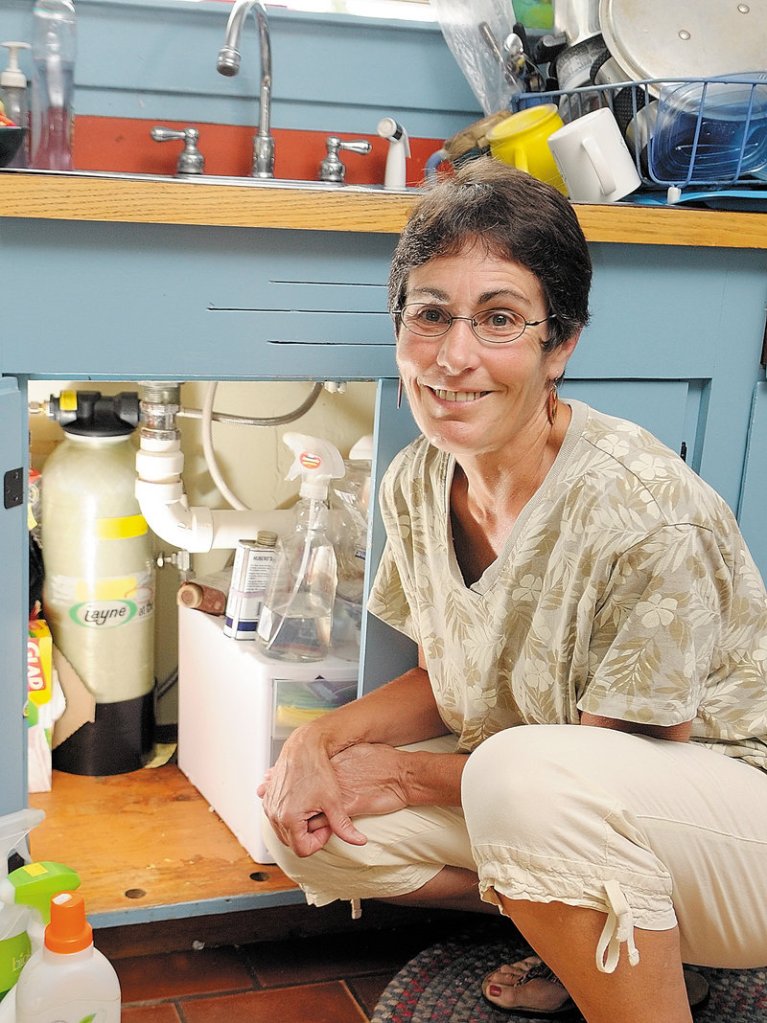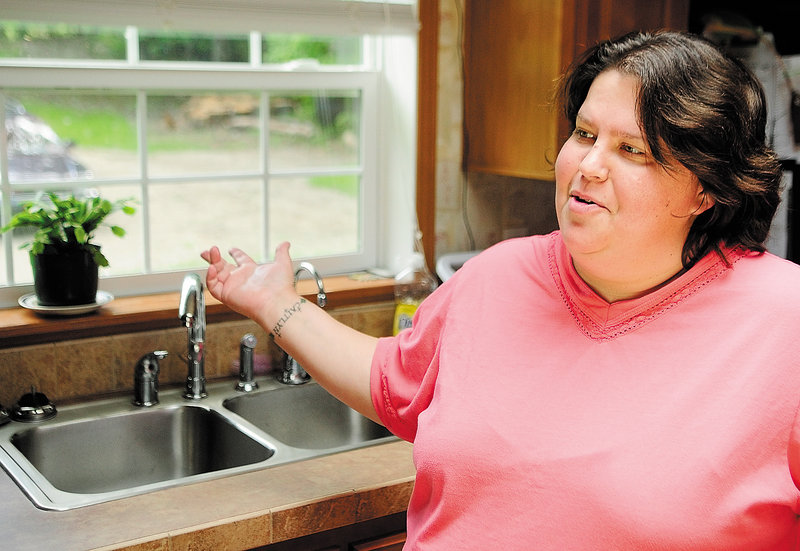MOUNT VERNON – There’s 10 times more arsenic in Wendy Brennan’s well than federal standards allow.
So it’s not surprising she jumped at the chance to get her 9-year-old daughter into a study examining the health risks to children exposed to arsenic.
Brennan, who lives on Wings Mills Road in Mount Vernon, says her well’s arsenic concentrations are nearly 100 parts per billion. The federal limit for arsenic in drinking water is 10 parts per billion.
She said her 9-year-old’s IQ test showed she was slightly below average in mathematics. Brennan’s 18-year-old daughter, who had been drinking the well water since the family moved into the home in 2000, also had problems in school with mathematics, as well as short-term memory problems, Brennan said.
She’s not sure the water had anything to do with those issues. Still, Brennan said she wished she had known sooner that the crystal-clear water her family was using to wash clothes, bathe and drink was toxic.
After finding out, the family installed an $800 point-of-use filter under the kitchen sink.
“Once we got the SPARK results, we stopped drinking our water and bought bottled water,” Brennan said. “I thought it was clean water. I have a granddaughter who’s 4 months old who will be drinking the water soon enough.”
Columbia University researchers, in conjunction with the University of New Hampshire, have been in Greater Augusta sampling the wells and testing the intelligence of children since 2006.
The Strategic Plan for Arsenic Research in Kids study (SPARK), which focuses on children in Greater Augusta, southern Maine and New Hampshire, is an outgrowth of a 2000 Columbia study in Bangladesh, where 50 million people were exposed to toxic levels of arsenic in drinking water.
There, researchers found a strong link between arsenic and children’s intellectual development: Bangladeshi children with the highest arsenic levels had the lowest test scores.
After seeing central Maine’s geologic profile and well tests that showed very high arsenic concentrations here, they wanted to compare what they found in Bangladesh with data collected in New Hampshire and Maine.
TESTING THE LIMITS
Carol Ladd, a Wayne resident and researcher for the Columbia University study, has been testing third-, fourth- and fifth-graders in Kennebec County.
She started testing children in Fayette and the Maranacook area school district — which serves Manchester, Mount Vernon, Readfield and Wayne — three years ago. This fall, she will be looking for more recruits, at Hall-Dale Elementary School and two schools in Monmouth: Henry Cottrell School and Monmouth Middle School.
Participating families sign up through the schools and receive free well-water tests to determine their arsenic levels. Then Ladd tests the children and their mothers to determine IQ. The testing will wrap up at the end of the year, she said.
“There’s an interview in the home to discuss child-rearing practices, and a little assessment with the mom,” Ladd said. “And then (I) clip the child’s toenails and take water samples. Then I get all that information and go to the schools and do the IQ test with the child.”
Thus far, 239 homes have been tested for arsenic in their well water. Of those, nearly half — 112 — registered above the federal standard. Some were six times the limit. Others, like the Brennans’, were even more toxic.
Qiang Yang, a Columbia University research scientist, did most of the well sampling.
His data showed an estimated 15,561 people in 17 Kennebec County municipalities are exposed to arsenic exceeding the federal limit. The municipalities are Augusta, Chelsea, China, Farmingdale, Hallowell, Litchfield, Manchester, Readfield, Sidney, Vassalboro, West Gardiner, Windsor, Winthrop, Belgrade, Monmouth, Mount Vernon and Waterville.
He said the project focuses on understanding and comparing the geochemical and hydrogeological factors that affect arsenic in the groundwater of New England and Bangladesh.
The aquifers in central Maine’s fractured bedrock are slightly different from the sedimentary aquifers in Bangladesh. And the socieoeconomic picture is vastly different.
But there are striking similarities between the two areas, including the fact that the rate of arsenic mobilization — from a solid into groundwater — was relatively constant and comparable.
HOW MUCH IS TOO MUCH?
Beyond a link to intelligence, people exposed to natural arsenic carry an increased risk for many kinds of cancer and other serious illnesses.
Arsenic is linked to skin, lung and bladder cancer; it can cause reproductive problems; it is linked to asthma, diabetes, cardiovascular disease and circulatory problems; and it affects the immune system. The National Research Council has concluded that even small amounts of arsenic over time can raise cancer risks.
State toxicologist Andy Smith said the level at which arsenic affects brain development is not well-established.
“There are a number of studies from around the world reporting that arsenic exposure is associated with lower intellectual function in children exposed both in the womb and after,” Smith said, “but we do not yet understand just how much water-arsenic exposure is needed for these effects to occur.
“Above 50 parts per billion, I would be concerned about the potential for effect on the developing brain. Below 50, I am not sure we know how concerned to be yet.”
The Maine Cancer Registry says the age-adjusted cancer incidence rate in 2007 was 515 cases per 100,000 Mainers — the highest cancer incidence rate in the nation. The national rate was 461 cases per 100,000.
The registry said the incidence rate in Maine is troubling because it does not follow a national trend of declining rates.
Maine men also get sick with bladder cancer at a higher rate than the national average, and Maine has the highest bladder cancer incidence for women in the country, according to the National Research Council.
A Dartmouth College study found exposure to small amounts of arsenic in drinking water inhibits a critical genetic function that enables cells to repair damaged DNA.
So, in people exposed to a carcinogen that can damage DNA — such as cigarette smoke or the sun — arsenic promotes the damaged cells’ progression to cancer by suppressing their DNA-repair mechanism, the study found.
“We were primarily interested in uncovering the mechanism to explain co-carcinogen — not directly causing cancer, but allowing other substances, such as cigarette smoke or ultraviolet light, to cause mutations in DNA more effectively,” said Angeline Andrew, research assistant professor for the Dartmouth study.
C.T. “Tom” Hess, a University of Maine physics professor, said the Dartmouth study shows the extent of the damage that arsenic can cause, even indirectly.
“The point of this is that these repair enzymes are very good for fixing broken parts of DNA and fixing the cell damage,” Hess said. “One of the ways cancer gets started is if cells are exposed to something and aren’t fixed so they go amok. It can cause cells to reproduce over and over, making the wrong type that grow into a tumor.”
Other studies in Maine include the National Cancer Institute’s ongoing New England bladder cancer study, which is analyzing the links between private well water and excessive rates of bladder cancer in the region.
ACTION AND PREVENTION
Yang, the research scientist, said Columbia researchers will return to Maine for more study, and to collect data on how people with private wells are reacting to various federal and state campaigns to reduce health risks.
Yan Zheng — project leader for the SPARK study, who currently is on a related assignment in Bangladesh — said one of the goals of the study is to help people protect themselves.
Yang said the Maine Geological Survey and the Maine Center for Disease Control and Prevention have been using the data from studies to encourage homeowners to test their water frequently. And they offer advice on how to deal with arsenic and other water contamination problems.
“There (is) some other potential contamination in the central Maine groundwater, such as radon, not to mention unfiltered water (that) could have high levels of iron and manganese,” Yang said.
He feels confident his study is working to educate people. Families whose wells test high for arsenic now know it, he said, and can do something about it.
The next step is action. Or not.
“There’s no one to take action except the homeowners themselves,” Zheng said. “It’s similar to quitting smoking. It’s a very individual decision.”
Kennebec Journal Staff Writer Mechele Cooper can be contacted at 621-5663 or at:
mcooper@centralmaine.com
Send questions/comments to the editors.



